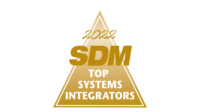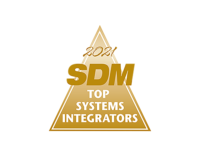ecurity integrators must embrace a constantly changing technology market. Such an embrace of technology must be compatible with all facets of the IT infrastructure and the Internet around us. They must provide skilled and motivated labor that aid in keeping project costs reasonable.
And they have to overcome all of these demands and insure that end-users and customers are happy, satisfied, and can use what they integrate. It’s a tall order, but one that will be rewarded with robust market opportunity in the years ahead.
Just three years ago, Grandview Research valued the global physical security systems market at $51.94 billion. Grandview believes that technological advancement will boost demand for physical security over the forecasted period. By their estimates the market should reach $110.09 billion by 2020.
Their research indicated that technological innovation to include IP networked systems have helped drive market demand.
The Continuous Challenge of Integrating Innovation
Technological innovation, though, is constantly changing. New innovation includes networks, devices and other IT infrastructure, as new and emerging technologies become popular, prominent and easier to implement.
“Some of the issues facing security integration include the rapidly changing technology and the changes to the customer profile,” says Richard McMullen, a partner with Security Solutions FCi in Ottawa, Ontario and National President of the Canadian Security Association (CANASA). “Today’s customer has a greater appreciation and understanding of technology, while still facing budget realities within their organizations. IT directors and a more technology savvy clientele create the need for a more informed integrator response. Being more responsive and better prepared with solutions will allow integrators better opportunities for success.”
Technology is not just within hardware, but depends upon more sophisticated capabilities that exist within an organization’s IT infrastructure.
Information technology is always dynamic. It never stops changing. Yesterday’s IT solutions have been improved already. And new IT solutions are coming online to replace older solutions. Any integrator must be aware of new and emerging IT solutions to best serve their customers.
“I think the biggest challenge comes as a result of the rapid adoption of IT based solutions across all aspects of the industry, from video to access control,” says Greg Taylor, VP Eastern Canada Operations for Convergint Technologies. “The skill sets of the technical force required to do true integration is changing quickly. IT as a common platform is creating cross functional and disciple opportunities never before thought of, and bringing into view the need for a converged view of logical and physical security.”
One facet of technology to watch in any integration project is technologies wired into the Internet of Things (IoT). IoT technology is becoming more innovative for security. This will allow more remote sensor monitoring making security systems more ubiquitous.
Security integrators will likely work at modifying existing systems and technology and installing new technology that integrates with other technologies via IoT. This includes multiple functions associated with smart devices, sensors, video displays, video analytics and power access systems. Integrators will likely be busy with the incorporation of cloud, intelligent and analytics-based security systems and real-time monitoring.
Integrators will face new opportunities with after-installation monitoring and trouble shooting using IoT, as its capability matures and brings more value to end users. Such monitoring will become more available. It will be more sophisticated and demand security integrators for its installation and maintenance.
Other emerging technologies, advanced IT infrastructure and other innovations are making their way into security projects and will challenge security integrators in future installations. They will all require a learning curve for integrators to install and maintain for end users and customers who demand a higher security standard. This will require technicians who understand the use of many different devices and their use in an integrated security system with IoT.
With the advent of the smart phone, apps and mobile devices of all sorts, everyone is more technically savvy than just a few years ago. The smart phone enables more do-it-yourself apps that enable many security functions.
“There is an increase in emerging technology offering consumers extended services DIY solutions to self-monitor, control their lighting, and home automation devices,” says Frank Pietrobono, Director of Business Development with AlarmForce Industries Inc. in Ontario, Canada. “The use of smart phones and tablets has become an enabler for the new technology as consumers learn to utilize applications available on these devices. Smart devices have become the controllers for the alarm system, video and home automation. This interactive, integration market segment is in its infancy stage and many new technology players are trying to find their spot in the new IOT world, while traditional security integrators are leveraging existing customers with additional services. The challenges facing the security integrator is managing the information about new technologies available to the end users and ensuring they are prepared to answer questions and deliver the best possible system for their customers that integrates all the various IoT devices onto one platform that is easy to program and easy to use.”
Ease-of-use is a desired end-state of customers. Technology might be sophisticated; however it requires implementation and interoperability that is aided by skilled technicians and professionals who are found on world-class security integration teams.
Ty Richmond, president of Security Systems Technology in Santa Ana, CA, believes that an organization’s ability to integrate security systems into the overall risk model of an enterprise, is a great challenge. This is particularly true as they face increasing risk from not only physical security, but also cybersecurity that may begin with tampering and intrusion of physical assets and access points.
“Issues impacting efficient and effective security asset deployment, and total solution interoperability require a different mindset and skill set,” he says. “Unfortunately, I think the path to get out of our traditional silos is still a challenge for both service providers and end users.”
Local Versus National Versus Regional
For security installations and integration, a common dilemma is whether to approach integration with local firms or larger regional or national ones. The geographic origin of the team performing the integration may not be nearly as important as the value provided from the fruits of their labor.
“I have seen a dramatic shift away from the national integrator to a more regional focus,” says McMullen. “Many national end-users are reaching out to regional integrators for solutions. This is often based on local requirements for responsive service as well as geographical realities. Some end users select a regional integrator that may provide services with a partner or subcontractor in other regions. This maintains a single contact and global billing and maintains the local service aspect. Regional regulations and requirements are often best represented by a local integrator.”
The quality and trust that a vendor, or team of vendors, brings to a facility or location is usually not dependent on geographical location. This may influence the outcome of the project as a local firm might acclimate to the environment quicker or better. It may, culturally, fit better if a team is local and more akin to the people they deal with and the setting in which they work. However, the quality of the work as well as the service provided carries more weight.
Pietrobono believes that end users buy based on three key elements: brand, price and customer service.
“Ultimately, end users buy a brand because they feel they can trust the security provider to deliver what they want, when they need it at a fair market price,” he says. “Having confidence in the integrator makes for a good customer experience and builds trust. If the integrator has service and installation capabilities, geographical barriers do not exist. The regional integrators do well in the respective communities as they cultivate the relationships and brand themselves as a local provider.”
An integrator who is not local may bring some valuable strengths to the project, however. If they’ve worked in all corners of a country or the world, they bring transferable skills; skills and knowledge that just may not be available locally. Facilities may be located in remote parts of the country and it’s very difficult to find any integrators in a particular region, never mind skilled ones who are in tune with the needs of an integration project.
However, Richmond believes it comes down to internal resources and skill sets of workers. “It’s a level of maturity from a master plan and enterprise standpoint; and how progressive they are to consider issues such as total cost of ownership with integrated electronic fire and security, remote video monitoring, and other broader solutions,” he says. “Local, regional and national players have varying degrees of capabilities but it has to align with where the end user is at that stage of their lifecycle.”
Today’s Successful Security Integrators
Finding and selecting integrators who fit the bill for your needs is a challenge. The characteristics of a successful integrator are dependent upon the needs and demands set forth by end-users. Many different variables factor into what is most desired of a security integrator, and care and attention must be paid to examine what’s needed and what price you’ll pay for what you need.
McMullen cautions that past performances as well as cost are dominant factors in landing a successful integrator for your job.
“I recommend end-users look at the total cost of ownership when selecting a partner,” says McMullen. “Look at the past history of the integrator; how long have they been in business; do they provide 24-hour service support; do they maintain an office with warehouse for spare or service parts; review their staff – who are they? How long have they been with the organization and what is their experience? Other considerations should include: background clearances for staff, certifications, training offerings and overall competency with the proposed solution. Consider the product and ease of support when selecting your integrator.”
Selecting the right integrator begins with identifying key characteristics about an integrator that poses the most value to your needs and demands.
Taylor points out some characteristics at the forefront include technical competency, and service responsiveness. He advises to look at what controls they use to measure and track service offerings. This can provide a sense for how the integrator monitors performance. Such monitoring will help them provide a better product that in the end will help determine the success of the overall project.
In addition, he feels it’s important to consider their company culture. A strong and effective corporate culture will be indicative of other important things such as who has authority, who makes decisions, and – are they easy to work with?
Because security technology is constantly changing, and it can be quite complex, it’s important to consider an integrator’s embrace of new technology. Are they constantly ahead of new technology? Do they examine the latest technology and know what it is and how it can benefit you?
“Having the ability to evaluate new products will help integrators find the best possible solutions for the end users,” says Pietrobono. “Integration is really about customizing solutions; although most of the systems sold are basic there is a growing segment of the market that wants a completely integrated system. These systems need to control the security, video, garages, thermostats, lighting and other devices such as a video doorbell.”
Of course, complex and new technology means that the integrator should have a staff of well-trained technicians, well versed in the technology and its installation. How they install the technology and manage the project is equally important. Pietrobono says good integrators must not over promise and under deliver. Instead, they need to do what they say they can do and in a timeframe that is reasonable for both parties.
Richmond says it’s important that they understand enterprise risk – what is most vulnerable for the customer assets they are tasked to secure?
This understanding of risk is best if it is pervasive throughout the entire organization and by all of the technicians. Their training and work culture is best when it fosters a culture that listens well and is able to spot problems before they occur – and responds with viable solutions. This is valuable to all stakeholders in a security installation and integration.
“At the end of the day,” says Richmond, “the team on the ground must be well managed and technically sound.”
So you have a qualified team of security integrators. They seem to have the right stuff, with many good characteristics and attributes that are suitable for the integration. Does this mean the project will be successful?
McMullen says one indicator of successful projects is the satisfaction of end users. If the end-user is not satisfied in the end, then it’s difficult to say the project is a success. And the integrator should be as satisfied as the end user. If the end user is not satisfied, neither should the integrator. McMullen says that where there’s project success, after-sales and service should follow. “I have always enjoyed seeing integration projects turn in to service agreements with maintenance and inspection agreements.
Taylor also says that end user satisfaction is a hallmark of project success. In the end, if the project is delivered on time and on budget, and it works as expected – to the satisfaction of end users – the project is successful.
He cautions that it is important that the customer understands the path forward. What also helps is if the customers do not feel locked into a proprietary system that limits their options and means they’re stuck with greater expenditures to stick with the system and its unique maintenance. This will greatly help in building customer satisfaction and create a successful project in the customer’s eyes.
Many Risks. Many Rewards.
The complexities of today’s security integration projects can be daunting as technology has become very complex; and so have the bad guys. There are many new risks that weren’t around years ago. There are also new ways that security can be violated. They all have intrinsic risks that must be mitigated; they also have many rewards.
Taylor says it’s important to note the progress that security integration has achieved over the past few years.
“It’s an exciting time. Things we could only dream of doing a few short years ago are now becoming commonplace; very complex integration that required expensive systems and proprietary hardware are now becoming open protocol solutions,” he says. “The Internet of Things (IoT) is becoming a reality; the horizon of sensor proliferation and expanded network bandwidth via Cellular LTE is further expanding what we can do.”
The road ahead for security integration will mean competing with Do-It-Yourself (DIY) solutions that, when presented, may be appealing to some. Proceed with caution.
“Security integrators have to keep a close watch on the new technology entrance into the market place, specifically the DIY solutions,” says Pietrobono. “Although I believe that the DIY technology is not quite there for end users, the integrator, and many of the big name companies, is working to find a solution that would have the customers purchase their devices from a local box store and self-install using their smart device to load an app that provides step by step instructions.”
As technology enables more DIY solutions, both end users as well as the many service providers in a security project will likely join forces to create better solutions.
“In the near future, customers and service providers in Canada and North America will have a consolidated, fixed monthly budget to create solutions,” adds Richmond. “This will include one set fee to create solutions with manned guarding, access control, video surveillance, intrusion detection, alarm monitoring and response, robotics, drones, situational awareness intel and a range of other ancillary products and services.”
“Security integration can be a challenging security offering with many risks and rewards along the way,” adds McMullen. “I always encourage integrators to do their homework and due diligence when responding to requests for proposals. I have seen many integrators fail to consider all of the requirements when submitting proposals. Understanding the costs, payment process and labor implications will help mitigate these risks. Offering end users with creative solutions is always a great way to ensure long-term success.”
Meet the Integrators
Richard McMullen — “Some of the issues facing security integration include the rapidly changing technology and the changes to the customer profile,” says Richard McMullen, a partner with Security Solutions FCi in Ottawa, Ontario and National President of the Canadian Security Association (CANASA).
Ty Richmond — Ty Richmond, president of Security Systems Technology in Santa Ana, CA, believes that an organization’s ability to integrate security systems into the overall risk model of an enterprise, is a great challenge. This is particularly true as they face increasing risk from not only physical security, but also cybersecurity that may begin with tampering and intrusion of physical assets and access points.









